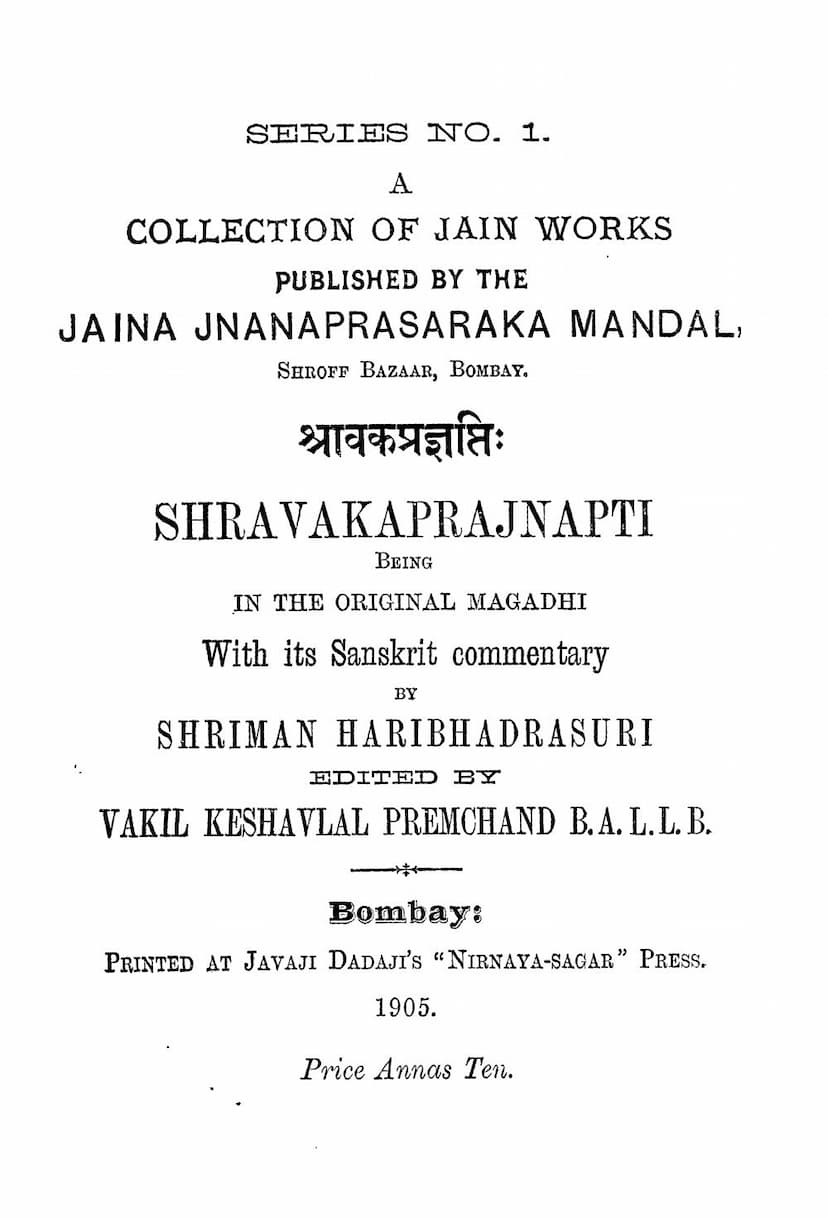Shravak Pragnapti
Added to library: September 2, 2025

Summary
Here's a comprehensive summary of the Jain text "Shravak Pragnapti" based on the provided information:
Book Title: Shravak Pragnapti (श्रावकप्रज्ञप्ति) Author: Possibly Hari Bhadrasuri (Shrimad Haribhadrasuri) for the original text and Vakil Keshavlal Premchand for the editing. The text itself is attributed to Umaswati Vachak in some parts, leading to scholarly debate. Publisher: Nirnay Sagar Press Published: 1905 Language: Original in Magadhi, with Sanskrit commentary by Hari Bhadrasuri. The provided text is likely a Gujarati translation or adaptation from the Sanskrit commentary, edited into a printed book.
Overall Purpose:
The "Shravak Pragnapti" is a foundational Jain text that meticulously outlines the duties, conduct, and spiritual path of a lay follower (Shravak). It serves as a guide for lay Jains to live a virtuous and ethically sound life, aiming for spiritual progress and ultimately liberation. The text defines what it means to be a true Shravak and details the practices necessary to uphold that status.
Key Themes and Contents:
-
Definition of a Shravak: The text begins by defining a Shravak not just by birth or title, but by their adherence to core Jain principles. A Shravak is someone who possesses right faith (Samyaktva), observes the vows (Anuvratas), and actively engages in daily spiritual practices, listening to the teachings of the saints (Yatis).
-
The Twelve Vows of a Shravak: A significant portion of the text is dedicated to explaining the twelve vows that form the backbone of lay Jain practice:
- Five Anuvratas (Minor Vows): These are the foundational vows for lay followers, representing a reduction in harmful activities compared to a householder without vows.
- Three Gunavratas (Subsidiary Vows): These vows enhance the practice of the Anuvratas and further limit indulgence.
- Four Shikshavratas (Training Vows): These are intermediate vows designed to train the practitioner towards more rigorous spiritual discipline and eventually monasticism.
-
Detailed Exposition of Vows: The text elaborates on each vow, including:
- Samyaktva (Right Faith): The text emphasizes the importance of Right Faith as the root of all virtues. It discusses its nature, its divisions (Kshayopashamika, Aupashamika, Kshaya), and its transgressions (Aticharas) like doubt, desire, and admiration of false doctrines.
- Ahimsa (Non-violence): The primary vow, Ahimsa, is discussed in detail, differentiating between deliberate and unintentional harm, and the scope of protection extended to different types of beings (mobile and immobile).
- Other Vows: The text also delves into the specifics of abstaining from falsehood, theft, sensual misconduct, and excessive accumulation of possessions, explaining their transgressions and the virtues associated with their observance.
-
The Karma Doctrine: The text integrates a detailed explanation of the eight types of karmas (Jnanavarniya, Darshanavarniya, Vedaniya, Mohaniya, Ayushya, Nama, Gotra, Antaraya), their sub-categories, and their effects on the soul. This understanding is crucial for comprehending the consequences of actions and the path to liberation.
-
Spiritual Practices and Conduct: Beyond the vows, the Shravak is guided on various aspects of daily life, including:
- Daily Routine: Observing rituals, meditation (Samayika), and mindfulness.
- Right Association: Associating with virtuous individuals and avoiding the company of the wicked.
- Moral Conduct: Maintaining honesty, contentment, and controlling desires.
- Charity and Service: Engaging in acts of charity (Dana) and service to the needy and the monastic community (Atithi Samvibhaga).
- Repentance and Auspiciousness: Observing periods of fasting (Paushadh) and engaging in practices that purify the mind and actions.
-
Transgressions (Aticharas): For each vow and practice, the text identifies specific transgressions that weaken or nullify the vow, urging the practitioner to be vigilant and avoid them.
-
Scholarly Discussion on Authorship: The introductory sections (Āmukh) highlight the scholarly debate regarding the authorship of the original text. While some evidence points to Hari Bhadrasuri, other references suggest Umaswati Vachak, and the text itself sometimes mentions "Umaswati Vachak" at the end of verses, adding complexity to its historical attribution. The editor, Keshavlal Premchand, acknowledges the efforts of various scholars and libraries in collating and preparing the manuscripts for publication.
-
Importance of Renunciation and Liberation: While guiding the lay follower, the text ultimately points towards the highest spiritual goal – liberation (Moksha). It emphasizes that through strict adherence to vows, right conduct, and the practice of virtues like non-violence, truthfulness, and contentment, the Shravak can progress spiritually, shed karmic bonds, and ultimately achieve freedom from the cycle of birth and death.
Significance:
"Shravak Pragnapti" is vital for Jainism as it provides a comprehensive framework for lay practitioners to live a spiritual life within worldly responsibilities. It demystifies the path to righteousness and emphasizes that spiritual advancement is accessible to all, regardless of their stage in life, through diligent practice and unwavering devotion to Jain principles. The text is a practical manual for ethical living and spiritual growth for householders.